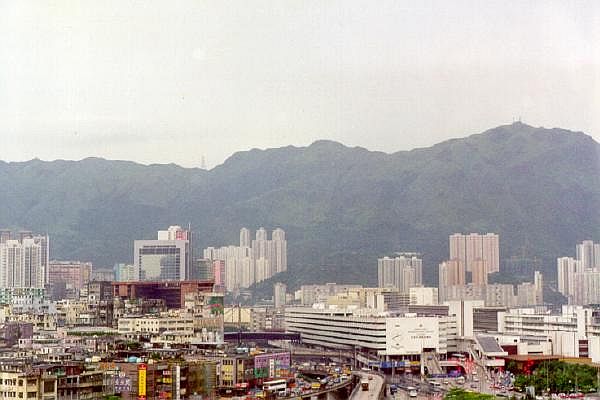|
Kai Tak Airport
Kai Tak Airport was an international airport of Hong Kong from 1925 until 1998. Officially known as Hong Kong International Airport from 1954 to 6 July 1998, it is often referred to as Hong Kong International Airport, Kai Tak, or simply Kai Tak and Kai Tak International Airport, to distinguish it from its successor, Chek Lap Kok International Airport, built on reclaimed and levelled land around the islands of Chek Lap Kok and Lam Chau, to the west. Because of the geography of the area, with water on three sides of the runway, Kowloon City's residential apartment complexes to the north-west and mountains more than high to the north-east of the airport, aircraft could not fly over the mountains and quickly drop in for a final approach. Instead, aircraft had to fly above Victoria Harbour and Kowloon City, passing north of Mong Kok's Bishop Hill. After passing Bishop Hill, pilots would see Checkerboard Hill with a large orange-and-white checkerboard pattern. Once the pat ... [...More Info...] [...Related Items...] OR: [Wikipedia] [Google] [Baidu] |
Tak Airport
Tak Airport is in Nam Ruem subdistrict, Mueang Tak district, Tak province in Northern Thailand, northern Thailand. From November 1990 to March 1994, Thai Airways International served the routes of Tak Airport. There are no airlines in service since then, but the Tak Airport is still in operation. In 2020, the Department of Royal Rainmaking and Agricultural Aviation has established the Northern Royal Rainmaking Project, Royal Rainmaking Operations Center in Tak Province, using the Tak Airport's area. The construction is expected to be completed in 2023, and planned to move all Northern Royal Rainmaking operations from the Chiang Mai Center and Chiang Mai Airport to the new Tak Center. Plans Airports of Thailand PCL (AOT) is budgeting 220 billion baht in 2018 for the creation of two new airports and the expansion of four existing airports owned by the Department of Airports (DOA). Tak Airport is one of the four slated for expansion and AOT management. AOT intends to build Chia ... [...More Info...] [...Related Items...] OR: [Wikipedia] [Google] [Baidu] |
Kowloon City
Kowloon City is an area in New Kowloon, Hong Kong. It is part of Kowloon City District. Compared with the council area of Kowloon City District, the Kowloon City area is History As early as in the Qin dynasty (221–206 BCE), Kowloon City was famous for its pearl production. During the Song dynasty (960–1279), Kowloon City was a part of Kwun Fu Cheung (), which was part of a salt yard governed by Chinese officials. During the late Song Dynasty, two young emperors, Zhao Bing and Duanzong, sought refuge at current day Kowloon City, roughly at present day Sung Wong Toi Garden, to escape from the growing Mongol Army. There are also historic relics and a temple which dates back to 800 years ago. Part of the area was the location of the original Kowloon Walled City, erected during the Qing dynasty. This is now Kowloon Walled City Park. The former Kai Tak International Airport was also located in the district. In 1982, Hong Kong was divided into 18 districts, and ... [...More Info...] [...Related Items...] OR: [Wikipedia] [Google] [Baidu] |
World War II
World War II or the Second World War (1 September 1939 – 2 September 1945) was a World war, global conflict between two coalitions: the Allies of World War II, Allies and the Axis powers. World War II by country, Nearly all of the world's countries participated, with many nations mobilising all resources in pursuit of total war. Tanks in World War II, Tanks and Air warfare of World War II, aircraft played major roles, enabling the strategic bombing of cities and delivery of the Atomic bombings of Hiroshima and Nagasaki, first and only nuclear weapons ever used in war. World War II is the List of wars by death toll, deadliest conflict in history, causing World War II casualties, the death of 70 to 85 million people, more than half of whom were civilians. Millions died in genocides, including the Holocaust, and by massacres, starvation, and disease. After the Allied victory, Allied-occupied Germany, Germany, Allied-occupied Austria, Austria, Occupation of Japan, Japan, a ... [...More Info...] [...Related Items...] OR: [Wikipedia] [Google] [Baidu] |


